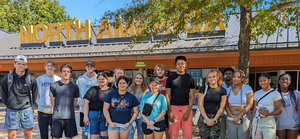
“I wanted my students to have the opportunity to spend some time thinking about how classroom concepts translate into the living world around us,” said Rushing. “During our visit, the students were able to traverse the Zoo at their own pace and let the amazing animals evoke their own sense of curiosity as they contemplated their research project topic.”
Students successfully researched and reported on the symbiotic relationships between microbes and various host organisms, including elk, bears, giraffes, honeybees, and more.
Throughout the semester, students also had several opportunities to meet their microorganisms “face-to-face” in the microbiology laboratory. Students completed a series of four laboratory projects that helped them learn how to use light microscopes to view microorganisms and practice collecting and culturing the helpful bacteria that live on their own skin. Near the end of the semester, students used their culturing skills to view bacteria from a unique perspective by creating works of art using colorful bacteria as “paint” and Petri dishes as the “canvas.”
"The lab activities tied together a lot of the ideas we went through as a class and in our reading,” said teaching fellow and Catawba senior Hunter Sjobom. “The activities also allowed for students to visualize the microscopic world that we were focused on, and in turn, created avenues for creativity, teamwork, and inspiration for learning more about microbes."
Students used their laboratory experiences to construct virtual microbiome museums at the end of the semester to showcase their work and to discuss how their perspectives about microbes changed by taking the course.
“This class has completely changed the way I think about microbes,” said student Caleb Schell. “Before, I thought they were something to be avoided at all costs, bringers of disease, and not belonging anywhere on or in myself. Of course, I still think of some microbes as harmful, but now I see most of them as an essential part of the growth and function of nearly all living things.”
